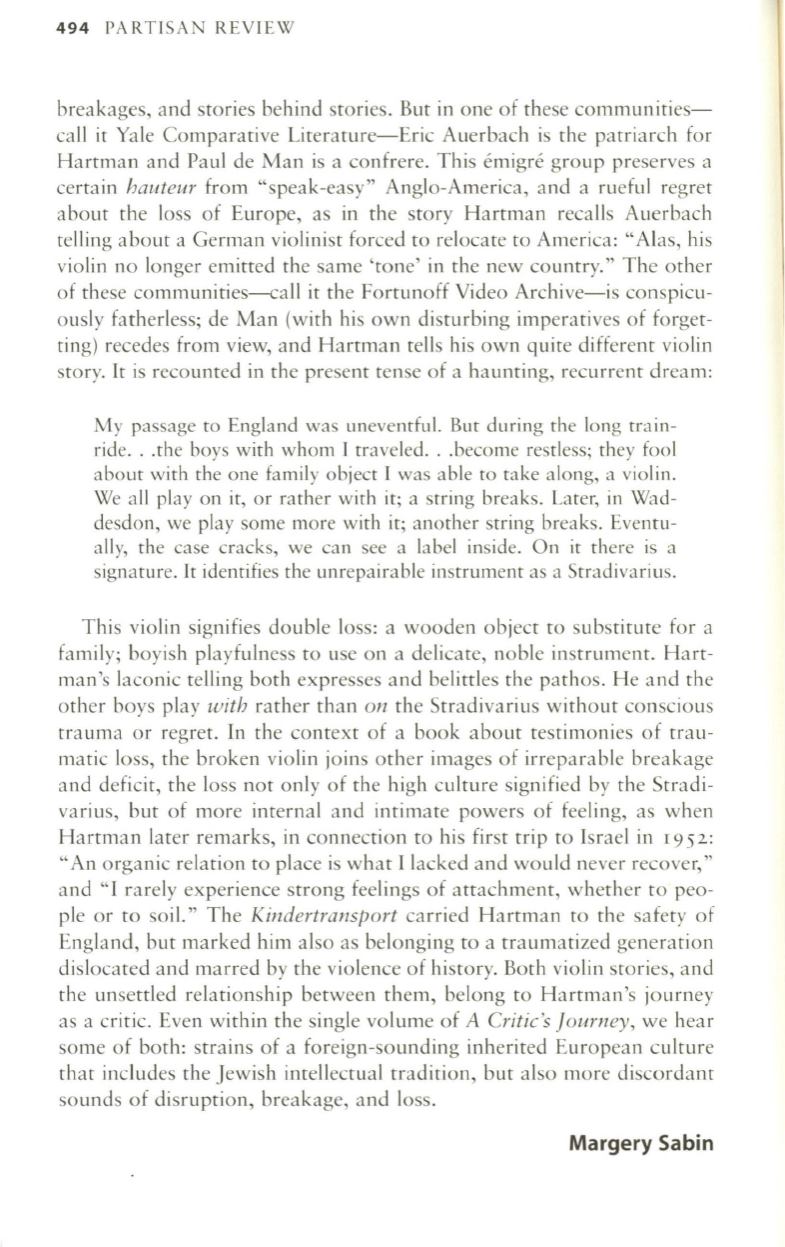
494
PART ISAN REV IEW
brea kages , and sto ries behind stori es. But in o ne o f these communiti es–
ca ll it Ya le Compa rati ve Litera ture-Eri c Auerbac h is the pa tri a rch fo r
Ha rtman and Pa ul de M an is a con frere. This emigre g ro up prese rves a
ce rta in
hauteur
from "spea k-easy" Anglo-America, and a ru eful regret
a bo Llt the loss o f Euro pe, as in the sto ry H a rtma n reca ll s Auerbac h
telling abo ut a German vi o linist fo rced to reloca te to Ameri ca: "Alas, hi s
vio lin no longe r emitted th e same 'tone' in the new country." The o ther
o f these communiti es-ca ll it the Fo rtuno ff Video Archi ve-is conspicu–
o usly fa therl ess; de Ma n (with hi s own di sturbing impera ti ves of fo rget–
ting) recedes fr om view, a nd Ha rtman tell s hi s own quite different vio lin
story. It is recounted in the present tense of a ha unting, recurre nt dream:
My passage to England was uneventful. Bur duri ng the long train–
ride. . .the boys with whom I trave led. .. become restl ess; they foo l
about with the one fa mil y o bject I was able to take a long, a vio lin.
We a ll play on it, o r ra ther with it; a string brea ks. Later, in Wad–
desdon, we pl ay some mo re with it; ano ther string brea ks. Eventu–
a ll y, the case cracks, we ca n see a label inside. O n it there is a
signa ture. It identi fies the unrepa ira ble instrument as a Stradi va riu s.
T hi s vio lin signifi es do ubl e loss : a wooden o bj ect to substitute for a
fa mil y; boyis h play fuln ess to use o n a deli ca te, no bl e instrument. Ha rt–
ma n 's laconi c telling bo th expresses a nd belittl es the pa th os. H e a nd the
o ther boys p lay
w ith
ra ther tha n
011
the Stradi va riu s with o ut consc io us
t ra uma o r regret. In the context o f a book a bo ut tes timo ni es o f tra u–
ma ti c loss, th e broken vio lin jo ins o ther images o f irrepa rab le breakage
a nd de fi cit, the loss no t o nl y o f the hi gh culture signifi ed by th e Stradi–
varius, but of more interna l a nd intima te powers o f fee ling, as when
Ha rtman la ter rema rk s, in connecti o n to hi s first trip to Israe l in
1952 :
"An orga ni c rela t ion
to
place is wha t I lac ked a nd wo uld neve r recover,"
a nd " ( ra rely ex peri ence st rong fee lings o f a ttachment, wheth er
to
peo–
p le o r to so il. " T he
Kindertransport
ca rri ed H a rtma n to the safe ty of
Engla nd, but ma rked him a lso as belo nging to a tra uma ti zed gene ra ti o n
di sloca ted and ma rred by th e vio lence o f hi story. Bo th vi o lin sto ri es, a nd
the unsettled rela ti o nship between them, belong
to
H a rtma n 's jo urney
as a criti c. Even within the sing le vo lume o f
A Critic's Journey,
we hear
some o f both: stra in s of a fo reign-sounding inherited Euro pea n culture
th a t includes the Jewi sh intell ectu a l traditi o n, but a lso mo re di scorda nt
so unds of di srupti on , brea kage, and loss.
Margery Sabin


